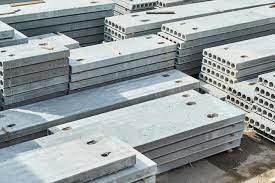Precast concrete slabs are precast offsite and then transported to the construction site for installation. They offer several advantages over traditional cast-in-place slabs, including reduced construction time, increased durability, and lower maintenance costs.
If you are planning to install precast concrete slabs, here is a step-by-step guide to help you get started:
Determine the slab design:
The first step is to determine the design of the precast slabs. The size and shape of the slabs will depend on the specific requirements of the project. The engineer will work with you to determine the appropriate dimensions, reinforcement requirements, and other design considerations.
Choose the appropriate precast manufacturer:
It is important to choose a reputable precast manufacturer that has experience in producing high-quality precast concrete products. The manufacturer should be able to provide a detailed design and fabrication plan, as well as references from previous projects.
Fabricate the precast slabs:
Once the design is complete, the precast slabs can be fabricated offsite. The manufacturer will pour the concrete into molds and allow it to cure before removing the slabs from the molds. The slabs are then transported to the construction site for installation.
Prepare the construction site:
Before the precast slabs can be installed, the construction site must be prepared. This includes preparing the base or subgrade, installing any necessary drainage systems, and ensuring that the site is level and free of debris.
Install the precast slabs:
Once the site is prepared, the precast slabs can be installed. The slabs are lifted into place using cranes or other lifting equipment and secured to the subgrade using anchors or other fastening systems. The joints between the slabs are then sealed to ensure a watertight seal.
Finish the slab:
After the precast slabs are installed, they can be finished according to the desired specifications. This may include adding a surface treatment or coating, installing insulation or vapor barriers, or adding other finishes such as tile or carpet.
Maintain the slab:
Precast concrete slabs require regular maintenance to ensure their longevity and safety. This includes regular inspections to check for signs of wear or damage, as well as repairs or replacements as needed.
Precast concrete slabs offer several advantages over traditional cast-in-place slabs. They are manufactured offsite, which allows for greater control over the quality of the concrete and reduces construction time. They are also more durable and require less maintenance than traditional slabs.
However, precast concrete slabs also have some limitations. They may not be suitable for all types of construction projects, and they can be more expensive than traditional cast-in-place slabs. In addition, they require careful planning and coordination to ensure that they are installed correctly and safely.
Overall, precast concrete slabs can be an effective solution for a variety of construction projects. With careful planning and installation, they can provide a strong and durable foundation for buildings, bridges, and other structures.

